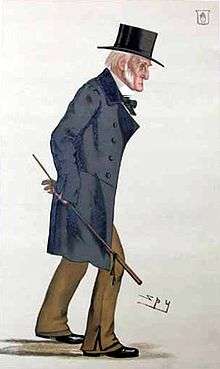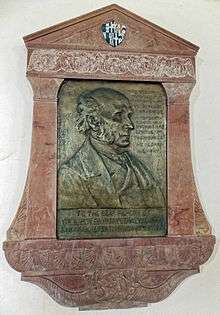Sir Harry Verney, 2nd Baronet

Verney as caricatured by Spy (Leslie Ward) in Vanity Fair), July 1882

Sir Harry Verney, 2nd Baronet PC, DL, JP (8 December 1801 – 12 February 1894)[1] was an English soldier and Liberal politician who sat in the House of Commons variously between 1832 and 1885.
Background and education
Born Harry Calvert, he was the oldest son of Sir Harry Calvert, 1st Baronet and his wife Caroline Hammersley, second daughter of Thomas Hammersley.[2] He was first educated at Harrow School, then aged fifteen went to the Royal Military Academy Sandhurst, as one of its first cadets.[3] In 1826, he succeeded his father as baronet and in the following year, he changed his surname by Royal Licence to Verney to inherit the Verney family estates of his cousin Mary Verney, 1st Baroness Fermanagh.[4] From 1831, he studied at Downing College, Cambridge,[5] befriending Adam Sedgwick and William Whewell.[6]
Career
Verney joined the British Army for the 31st (Huntingdonshire) Regiment of Foot in 1819 and was sent to the country's legation in the German states Württemberg and Baden, learning during this time German, French and Italian.[6] He returned to England in the following year and was allocated to the 7th (Royal Fusiliers) Regiment of Foot.[6] From 1824, he served with the Grenadier Guards and from 1826 was private secretary in the office of the Commander-in-Chief of the Forces.[3] Verney was meant to accompany Lord William Bentinck on his appointment as Governor-General of India, however during the journey was left ill in Rio de Janeiro, where he recovered, later hunting with natives in the Pampas and the Andes.[6] His voyage home led him around the Cape of Good Hope on board a ship, commanded by Sir Michael Seymour and in 1829, he arrived in England again.[6] Verney was promoted to major in 1831 and was transferred to the Royal Buckinghamshire Militia (King's Own) in 1844, retiring two years later.[3]
Verney entered the British House of Commons in 1832, sitting as a Member of Parliament (MP) for Buckingham until 1841.[7] After a six-year break, he was successful for Bedford and represented it until 1852.[8] Verney was again returned for Buckingham in 1857 until the 1874 general election.[7] In 1880, he was reelected for the constituency for the following five years.[7] In 1885, in his final year in the House, Verney was sworn a Privy Counsellor.[3]
Verney was nominated a Deputy Lieutenant of Buckinghamshire and a Justice of the Peace for the same county.[9] He was a fellow of the Royal Geographical Society and one of the founders of the Royal Agricultural Society.[6] Verney acted as chairman of the Buckinghamshire Railway Company and deputy chairman of the Aylesbury and Buckingham Railway Company.[9]
Family
On 30 June 1835, he married firstly Eliza Hope, daughter of Admiral Sir George Johnstone Hope, and had by her four sons and three daughters.[10] After her death in 1857, Verney remarried secondly Frances Parthenope Nightingale, daughter of William Edward Nightingale and sister of Florence Nightingale, on 24 June 1858.[10] He died, aged 92 and was succeeded in the baronetcy by his oldest son Edmund.[11] His youngest son Frederick was a diplomat and politician and father of Sir Ralph Verney, 1st Baronet.[12]
Legacy
Verney was unusual in the sense that he gave his name to two railway stations in England, namely Calvert and Verney Junction stations in Buckinghamshire.[13] Mount Verney, Sir Harry Peak and Sir Harry Range in British Columbia were also named after him.[14] To this day, one of the campuses of the University of Buckingham (housing the Law School) is named "Verney Park".[15]
References
- ↑ "Leigh Rayment – Baronetage". Retrieved 22 October 2009.
- ↑ Walford, Edward (1860). The County Families of the United Kingdom. London: Robert Hardwicke. p. 656.
- 1 2 3 4 Debrett, John (1893). Debrett's Peerage, Baronetage, Knightage and Companionage. London: Oldhams Press. p. 550.
- ↑ The London Gazette: no. 18347. p. 724. 27 March 1827. Retrieved 22 October 2009.
- ↑ "Verney (formerly Calvert), Sir Harry, Bart. (VNY829SH)". A Cambridge Alumni Database. University of Cambridge.
- 1 2 3 4 5 6 Lee, Sidney (1899). Dictionary of National Biography. vol. LVIII. Smith, Elder & Co. pp. 277–278.
- 1 2 3 "Leigh Rayment – British House of Commons; Buckingham". Retrieved 22 October 2009.
- ↑ "Leigh Rayment – British House of Commons, Bedford". Retrieved 22 October 2009.
- 1 2 Debrett, John (1881). Robert Henry Mair, ed. Debrett's House of Commons and Judicial Bench. London: Dean & Son. p. 233.
- 1 2 Lodge, Edmund (1859). The Peerage and Baronetage of the British Empire (28th ed.). London: Hurst and Blackett. p. 785.
- ↑ Fox-Davies, Arthur Charles (1895). Armorial families. Edinburgh: Grange Publishing Works. p. 996.
- ↑ "ThePeerage – Sir Harry Verney, 2nd Bt". Retrieved 10 January 2009.
- ↑ "Subterranea Britannica – Calvert Station". Retrieved 22 October 2009.
- ↑ "Government of British-Colombia, Official Website – Crown Registry and Geographic Base". Retrieved 22 October 2009.
- ↑ http://www.buckingham.ac.uk/life/campusmaps
External links
- Hansard 1803–2005: contributions in Parliament by Sir Harry Verney, 2nd Baronet
- Portraits of Sir Harry Verney, 2nd Baronet at the National Portrait Gallery, London

| Parliament of the United Kingdom | ||
|---|---|---|
| Preceded by Sir Thomas Francis Fremantle Sir George Nugent |
Member of Parliament for Buckingham 1832 – 1841 With: Sir Thomas Francis Fremantle |
Succeeded by Sir Thomas Francis Fremantle Sir John Chetwode |
| Preceded by Frederick Polhill Henry Stuart |
Member of Parliament for Bedford 1847 – 1852 With: Henry Stuart |
Succeeded by Samuel Whitbread Henry Stuart |
| Preceded by John Hall Marquess of Chandos |
Member of Parliament for Buckingham 2-seat constituency until 1868 1857 – 1874 With: John Hall 1857–1859 John Gellibrand Hubbard 1859–1868 |
Succeeded by Egerton Hubbard |
| Preceded by Egerton Hubbard |
Member of Parliament for Buckingham 1880 – 1885 |
Succeeded by Edmund Hope Verney |
| Baronetage of the United Kingdom | ||
| Preceded by Harry Calvert |
Baronet (of Claydon House) 1826–1894 |
Succeeded by Edmund Verney |